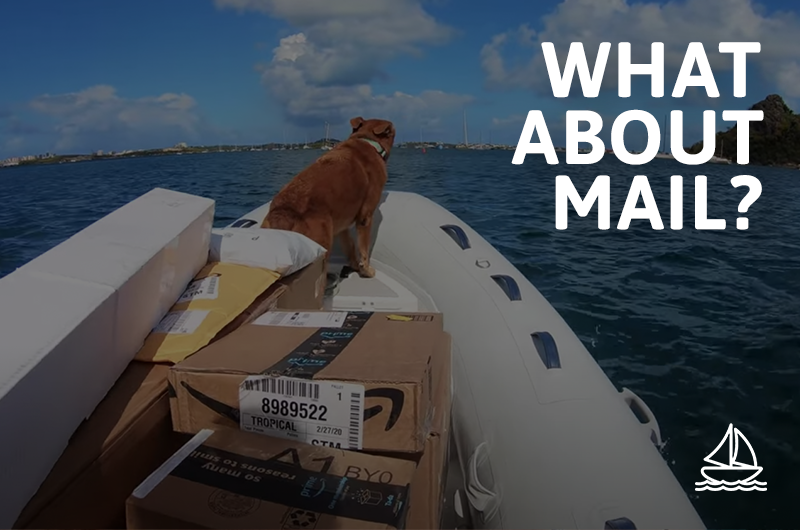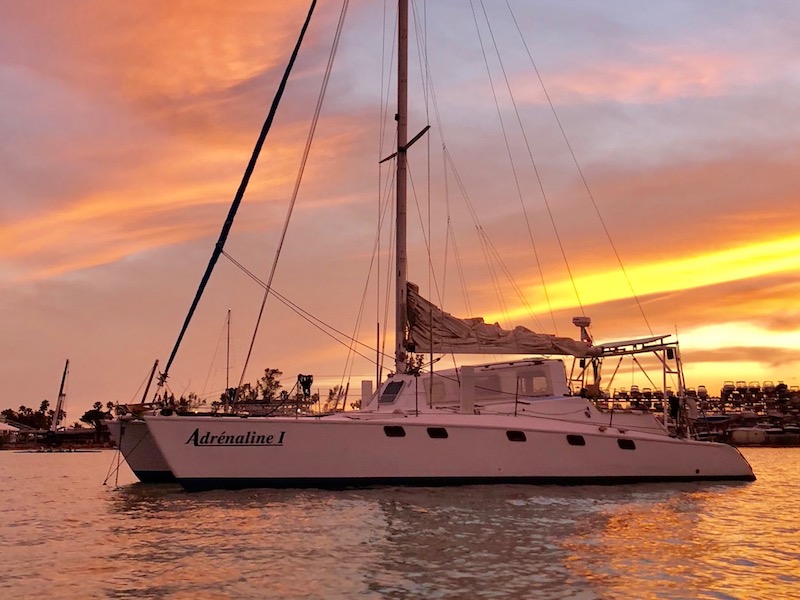We recently replaced our lifelines aboard our Catamaran Adrenaline. The old ones were conventional vinyl coated stainless steel wire and had rust protruding from the machine swaged terminals as well as a few spots in the cracked vinyl. Replacement for these lifelines was long overdue.

Old Vinyl Coated Lifelines
I wanted to stay away from vinyl coated lifelines because it creates an opportunity for salt water to sit, hidden, and corrode the SS wire underneath. We chose bare 1×19 wire initially and long story short our source for the wire was questionable (amazon) and it started rusting after just a few months. After about a year we replaced our lifelines again, this time with Dux, a type of heat-set dyneema, and dyneema lashings with Colligo terminators to tension the lines.

Bare 1×19 SS Lifelines
In the process of deciding which direction to go, I did a ton of research on our options and the costs associated with each. I will outline all these options below with their costs as well as some advantages and disadvantages of each. For this comparison we used our boat’s lifeline setup as the standard. We measured a 35′ run from bearing point to bearing point for each line and we have no gates which makes our setup very simple. We do however have a third lower lifeline when many other sailboats only have two lifelines.
The three main lifeline materials to choose from are vinyl coated ss wire, bare 1×19 ss wire, and dyneema. We left out the vinyl coated option in our comparison for the reason mentioned above. The standard diameter for lifeline wire seems to be 3/16″ (5mm for dux) so we used that in each setup.
No matter which material you choose for your line, each end must be terminated. With ss wire this is done with either a mechanical fitting, hand-swage fitting, or machine swage fitting. We left out the hand-swage option for our comparison because you need a special hand swage tool and shopping around for the proper studs, matching them with the turnbuckles and opposite studs, and getting the direction of threads correct was taking a ton of time and a pain. To terminate dyneema lifelines you use a locking brummel splice and a colligo terminator or stainless steel high-load thimble.
Each lifeline also needs a tensioning method. With ss wire this is done with a turnbuckle and with dyneema it can be done with lashings, a turnbuckle, or both.
Our comparison starts with a diy setup with all products from Sailrite This lifeline setup includes 1×19 ss wire with mechanical fittings and turnbuckles from a company called Suncor. Our 35′ run requires just under 35′ of ss wire but sailrite only sells wire in 40′ lengths so we needed a total of x6 40′ lengths which run $50.95 each. We needed x6 mechanical fittings to terminate the wire into a toggle ($41.95 each) and on the other end, another x6 mechanical fittings that terminate the wire into a stud for one side of the turnbuckle which are $44.95 each including the turnbuckle and stud/toggle on the opposite side. The total for this entire setup is $827.10 in materials. The mechanical fittings only require two wrenches to compress the inner wedge kit onto the ss wire and is pretty easy for a diy project. Once you have the suncor fittings, if you ever have to replace your lifelines you can usually re-use the same fittings and just replace the inner wedge kit which are $16.96 each vs. the original $41.95 for the whole fitting/toggle. The advantages to this system are that it is totally diy friendly, and may be a cheaper option for future replacement. You can also carry some spare wire and wedge kites aboard for any replacements in super remote areas while cruising. Disadvantages include being more expensive than other options and possibly not as strong a fitting as other options.
Our next comparison is a similar setup with all products through defender. This lifeline system also includes mechanical fittings only requiring two wrenches to install but this time we looked at sta-lok products which uses a slightly different cone wedge to secure the fitting onto the wire. We would need x6 sta-lok fitting/toggles at $46.99 each, x6 sta-lok fitting/studs at $39.99 each and x6 turnbuckles with stud/toggle on one side at $38.99 each.. From defender you can order 1×19 wire by the foot and we estimated 35′ run each even though we need probably just a bit less. At $1.39/ft. the total for wire is $291.90 and the total for this whole system would be $1047.72. Advantages include: DIY capability, very strong mechanical fitting (many use for standing rigging), and ability to carry spares. Disadvantages include: Expensive, ability for water to sit and corrode in fitting (this can be combated by including some sort of sealant before the fitting is compressed).
Our third option for replacement lifelines is to get them made up from a professional rigger with a machine swage. We received a quote from Mack Sails in Stuart, FL for the exact length lifelines we needed in bare 1×19 stainless including all the sta-lok brand turnbuckles, fittings, and toggles required. They would do all the labor of measuring/cutting the wire and swaging on the fittings. Their total quote was $663. Advantages: Cheapest option, professional work, reliable source of materials, no DIY necessary. Disadvantages: Must be local or have shipped, no re-use of fittings when replacement is needed (turnbuckles/toggles can be inspected and re-used), might have to wait a few weeks depending on their work load. Here is the website to Mack Sails.
In this video we replaced our lifelines with bare 1×19 wire that I bought on amazon (bad idea) and Mack Sails swaged on fittings for us. (Should have had them do everything).
Our last comparison for replacement lifelines aboard a sailboat is synthetic line. We chose Dyneema Dux for our comparison and on our own boat. Dux is a type of dyneema from Colligo Marine that is pre-heat stretched to take all the stretch out of the line so that constant adjustment is not necessary. The total amount of Dux needed we ordered was about 235′ to allow for take-up and extra length required for the splices. Dux from Colligo costs $2.85/ft. The forward ends of all our lines were locking brummel eye spliced then luggage tagged to an eye-bolt in our crossbeam so no additional hardware was required. The aft ends were eye spliced and terminated with Colligo Lifeline Terminators which are $33.32/each. These were then lashed to our stern stanchion structure using regular 4mm sk75 dyneema lashing line which costs $0.90/ft. Our total cost on this setup was $905.67. All you need to do the splicing is a small fid kit and a short amount of time to learn the locking brummel splice. Advantages are: DIY very friendly, lightest option for performance boats, spares are light and easy to carry aboard, easily inspectable (line frays well before there is risk of it failing), stronger than 3/16″ SS wire, can re-use terminator fittings, no corrosion to worry about, simple. Disadvantages: Not the cheapest option, may not last as long as wire due to chafe or UV, may need to smooth stanchion holes or add cover/tube.
Here is a video of us installing our Dux lifelines.
A few notes on using synthetic line. It is very tough stuff and relatively UV resistant as far as line goes but any surface it touches needs to be rounded and smooth (stanchions). Or, you can use plastic tubing or chafe sleeve where it passes through stanchions. You could also chafe sleeve the whole line with something like Marlow dyneema chafe sleeve which would also protect the line from UV and would make the line last virtually forever if the cover was never chafed through to the core. Colligo Marine has done some testing and determined that bare Dux is safe to use for at least 5-8 years in the tropics. You can tension synthetic lifelines with turnbuckles but you must measure and splice precisely or you can use lashings and turnbuckles but I have found that lashings were plenty sufficient and I only had to adjust them once after I installed them because I did not pre-stretch the line to take the constructional stretch out of the splices. In addition, you can use high-load SS sailmaker thimbles instead of Colligo terminators to save some money. However, you need to make sure the lashing lines do not “jump” and ride over each other when tensioning and there may be more friction when tensioning because of the lines touching each other vs. Colligo terminators where each line has it’s own hole.

Colligo Lifeline Terminator
Here is a table I prepared with all the information discussed above on different lifeline replacement options. There are probably a ton of other options and brand available. I looked at some Hayn prices on defender which seemed to be right in-line with sta-lok. You could use regular sk-75 or sk-78 dyneema but you really shouldn’t unless you pre-tension it a ton to take all the initial creep out. Lifelines should be tight and constant adjustment could be a pain. I hope this helps if you are thinking of replacing your lifelines. Please shoot us a comment below and feel free to share this article link!

Lifeline Replacement Options
**Prices are as of the published date of this article and are subject to change **
***Some of the links in the article are affiliate links and we may earn a small commission if a purchase is made through them which helps fund this website and our videos***




